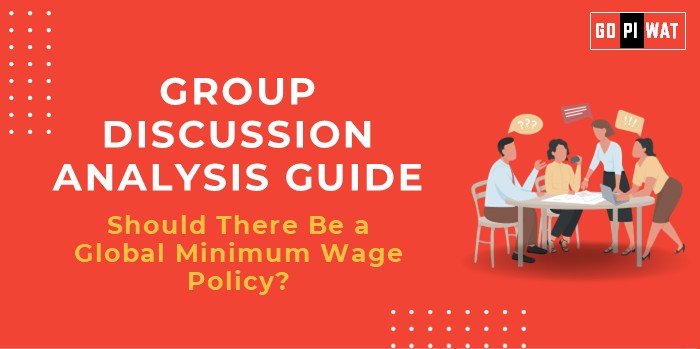📋 Group Discussion (GD) Analysis Guide: Should There Be a Global Minimum Wage Policy?
🌐 Introduction
Context: The debate on a global minimum wage policy arises from stark global income disparities. While high-income nations control 70% of global wealth, 9% of the global population still survives on less than $2.15 a day. Advocates see it as a tool to promote equity and fairness, but critics question its feasibility in a world of diverse economic systems.
📊 Quick Facts & Key Statistics
- Global Inequality: Over 9% of the world’s population lives on less than $2.15 per day (World Bank, 2021).
- Wealth Distribution: High-income countries account for 70% of global wealth, while low-income nations make up only 1%.
- Wage Variance: In 2023, the median global wage was approximately $10 per day, with developed nations like Switzerland exceeding $25/hour and Bangladesh below $1/hour.
- ILO Advocacy: 80% of workers globally lack adequate minimum wage protections, and compliance rates are under 50% in many low-income countries (ILO, 2022).
- Economic Impact: A $3/hour global minimum wage could uplift 1.3 billion workers but may increase labor costs in low-income nations by 20%.
👥 Stakeholders and Their Roles
- International Organizations: The ILO and UN push for equitable wage policies globally.
- National Governments: Set and enforce labor laws, balancing economic growth with social equity.
- Corporations: Adapt operations to rising labor costs and ethical practices.
- Labor Unions: Advocate for fair wages and improved working conditions.
- Economists: Analyze macroeconomic impacts and propose viable frameworks.
📈 Achievements and Challenges
Achievements:
- National wage policies in countries like Germany and Brazil have reduced poverty levels.
- Increased awareness of labor rights in global supply chains.
- EU nations have established regional wage benchmarks.
Challenges:
- Economic Variance: Cost-of-living differences make global policies complex.
- Enforcement Gaps: Over 50% of low-income nations lack compliance mechanisms.
- Inflation Risks: A 10% wage hike could increase global inflation by 0.8%.
📌 Effective Discussion Approaches
- Opening Techniques:
- “Over 1.3 billion workers could see improved livelihoods with a global minimum wage.”
- “While Switzerland offers over $25/hour, workers in Bangladesh earn less than $1/hour, showcasing the disparity.”
- Counter-Argument Handling:
- Propose phased implementation starting with regional wage standards.
- Highlight the role of technology in managing wage compliance and reducing costs.
🔍 Strategic Analysis of Strengths & Weaknesses
- Strengths: Global equity, poverty reduction, ethical labor standards.
- Weaknesses: Implementation costs, economic diversity.
- Opportunities: Collaboration between governments and corporations, inclusive growth.
- Threats: Resistance from businesses, inflationary pressures, job losses.
📌 Structured Arguments for Discussion
- Supporting Stance: “A global minimum wage policy ensures fair compensation, uplifting over a billion workers.”
- Opposing Stance: “Diverse economic conditions make a universal wage policy unviable, risking inflation and job loss.”
- Balanced Perspective: “A phased, region-specific approach to minimum wages can balance equity with economic feasibility.”
🌍 Connecting with B-School Applications
- Real-World Applications: Relevant for courses on global economics, CSR, and HR management.
- Sample Questions:
- “How can businesses adapt to global minimum wage regulations?”
- “What are the macroeconomic implications of a universal wage policy?”
- Insights for B-School Students: Analyze global labor markets, address wage-related compliance, and promote sustainable practices.


